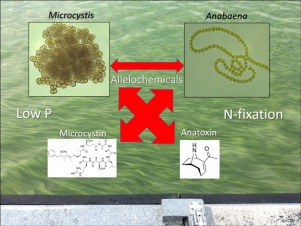Harmful Algae ( IF 5.5 ) Pub Date : 2018-04-13 , DOI: 10.1016/j.hal.2018.03.002 Mathias A. Chia , Jennifer G. Jankowiak , Benjamin J. Kramer , Jennifer A. Goleski , I-Shuo Huang , Paul V. Zimba , Maria do Carmo Bittencourt-Oliveira , Christopher J. Gobler

|
Microcystis and Anabaena (Dolichospermum) are among the most toxic cyanobacterial genera and often succeed each other during harmful algal blooms. The role allelopathy plays in the succession of these genera is not fully understood. The allelopathic interactions of six strains of Microcystis and Anabaena under different nutrient conditions in co-culture and in culture-filtrate experiments were investigated. Microcystis strains significantly reduced the growth of Anabaena strains in mixed cultures with direct cell-to-cell contact and high nutrient levels. Cell-free filtrate from Microcystis cultures proved equally potent in suppressing the growth of nutrient replete Anabaena cultures while also significantly reducing anatoxin-a production. Allelopathic interactions between Microcystis and Anabaena were, however, partly dependent on ambient nutrient levels. Anabaena dominated under low N conditions and Microcystis dominated under nutrient replete and low P during which allelochemicals caused the complete suppression of nitrogen fixation by Anabaena and stimulated glutathione S-transferase activity. The microcystin content of Microcystis was lowered with decreasing N and the presence of Anabaena decreased it further under low P and high nutrient conditions. Collectively, these results indicate that strong allelopathic interactions between Microcystis and Anabaena are closely intertwined with the availability of nutrients and that allelopathy may contribute to the succession, nitrogen availability, and toxicity of cyanobacterial blooms.
中文翻译:

微囊藻和鱼腥藻(Dolichospermum)绽放的演替和毒性受养分依赖性化感相互作用的控制
微囊藻和鱼腥藻(Dolichospermum)是毒性最高的蓝细菌属,在藻类大量繁殖时常常会相互继承。尚未充分认识到化感作用在这些属的继承中所起的作用。研究了6种微囊藻和鱼腥藻在不同营养条件下在共培养和培养滤液实验中的化感作用。微囊藻菌株在直接与细胞接触和高营养水平的混合培养物中显着降低了鱼腥藻菌株的生长。事实证明,微囊藻培养物中的无细胞滤液在抑制营养物质生长方面同样有效鱼腥草文化,同时也大大减少了anatoxin-a的生产。然而,微囊藻和鱼腥藻之间的化感相互作用部分取决于环境养分水平。在低氮条件下,鱼腥藻占主导地位,在营养充足和低磷条件下,微囊藻占主导地位。在此期间,化感物质完全抑制了鱼腥藻对固氮的抑制,并刺激了谷胱甘肽S-转移酶的活性。随着氮含量的降低和鱼腥藻的存在,微囊藻的微囊藻毒素含量降低。在低磷和高养分条件下,其含量进一步降低。总的来说,这些结果表明微囊藻和鱼腥藻之间的强化感相互作用与养分的可用性紧密地交织在一起,而化感作用可能有助于蓝藻花序的演替,氮的有效性和毒性。











































 京公网安备 11010802027423号
京公网安备 11010802027423号